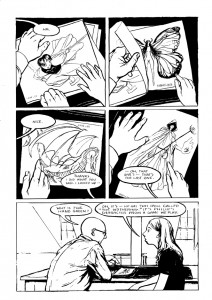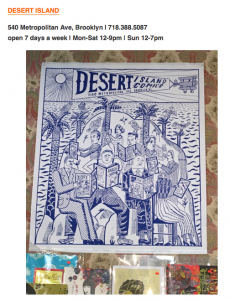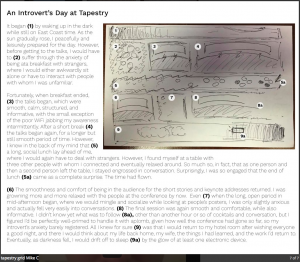Aaron CockleFebruary 6, 2017NewsAaron here today with Roman Muradov; ‘Elitist Empathy’; What we talk about when we talk about ‘A study of issues relating to the collection, care, and accessibility of zines in institutional and alternative collections in the UK’; 2 Robs at TCJ, writing about comics; Ley Lines; INK BRICK; Furie explains Pepe, Pepe explains Furie
—————————————————————————————————
Roman Muradov on How I Didn’t Write Certain of My Books
To hell with narrative and self-expression! Instead: constraints and repetition (and repetition)! This talk sets Idleness against Inspiration, and namedrops an indecent number of French names in the process. Reader, attend!!
The 176th meeting of the NY Comics & Picture-story Symposium will be held on Tuesday, Feb. 7, 2017 at 7pm at Parsons School of Design, 2 West 13th Street, in the Bark Room (off the lobby). Free and open to the public.
Roman Muradov is an award-winning illustrator and the author of (In A Sense) Lost & Found, Jacob Bladders and the State of the Art and the End of A Fence, as well as a French collection Aujourd’hui Demain Hier. He has a Gold Medal from the Society of Illustrators, a habit of long aimless walks, and an imaginary dog named Barchibald.
—————————————————————————————————
NOTHING LEFT TO LEARN 13
nearly 60 pages of content regarding race, post-liberal America, and the election.
essays and rants from Jason Lee
illustrations by Laura PallMall
“Things That Kill More Americans than ISIS”
SPECIAL INSERT: for the first time in print “Greek Church,” a 15 page comic by PallMall
for an extra 25 dollars you can purchase the original drawing of any illustration from the zine. please email laurapallmall at gmail dot com before ordering this option to confirm the availability of your desired drawing.
50% of all proceeds from this zine forever will go to CAIR.
NOW AVAILABLE FOR PRE-ORDER.
—————————————————————————————————
Zines in the Academy?
Siobhan Britton’s University College London’s dissertation, What we do is secret? A study of issues relating to the collection, care, and accessibility of zines in institutional and alternative collections in the UK, has been posted for your downloading/reading pleasure.
Here is the abstract:
Fanzines, or ‘zines’ are self published magazines with small print runs, where the entire process from creation to distribution is done by the maker and generally not created for profit. Their subject matter can be almost anything. They are distinctly anti-commercial a, often acting as an outlet for alternative or marginalised voices, which are often ignored by mainstream publishing. The UK has a strong zine culture, and an increasing number of libraries here are developing zine collections. There are also a number of alternative spaces such as self organised zine libraries and anarchist social centres which do the same thing. The first chapter sets out the context of the dissertation, and flags up the fact that most of the research and literature about zine collections in both institutional and alternative spaces is very USA-centric. As a result the study of UK zine collections is important in terms of the focus of this dissertation. Chapter two considers the way that zines might be defined. Using a combination of face to face and written interviews with people responsible, and fieldwork in the form of visits, this dissertation examines a selection of both institutional and alternative zine collections located in UK and examines how they collect, care for, and make accessible their collections in the third and fourth chapters. The concluding chapter draws examines the issues that UK institutional and alternative zine collections face, including the argument for and against collecting zines at all. Although this study does not consider every institutional or alternative zine collection in the UK, and therefore cannot be considered comprehensive, it aims to give an idea of the range of collections that exist here.
—————————————————————————————————
Dueling Roberts at The Comics Journal
Rob Kirby reviews the recent Spanish Fever anthology, edited by Santiago Garcia:
The talent roster in Spanish Fever ranges from well-known pros like Miguel Gallardo and Max, to newer artists like Ana Galvañ and Clara-Tanit Arqué. There’s a wide variety of narrative and visual styles, ranging from traditional underground comix to the ubiquitous European “big nose” style to work that would look at home in an American minicomic. In subject matter, the stories range from autobiographical, political, and quotidian to surreal and just flat-out weird. It’s an eclectic stew that comes together agreeably, making a good case for the vibrancy of the Spanish comics scene, though a few weaknesses keep it from being a truly top-notch compendium.
In his introduction, Eddie Campbell notes that the new Spanish comics all share the importance of authorial voice, i.e., that they feature characters that are pure expressions of the authors, beholden to no meddling publishers or corporations. Garcia’s forward to the collection extrapolates on this theme, offering a mini-history of Spain’s comics leading to its current artistic renaissance amid the country’s current economic crisis.
And Rob Clough gives a characteristically comprehensive run-down of some short-form comics highlights from 2016:
26. Faded Frankenstein, by E.A. Bethea. Bethea’s scratchy, scrawled line is a perfect complement for her poetic and heartfelt prose about missing friends, fading memories, and the images of jobs past.
27. Zebidiah Part 3, by Asher Z. Craw. Part autobio story about embracing one’s identity as a trans person, and part magical realist adventure, the genius of the story is the way Craw wrapped both up together in telling the tale of Zebediah and Eula-Lee, who were pursued by the forces of evil into their modern-day incarnations as Asher and Lillie (Craw’s actual wife) Craw.
28. Paper Pencil Life #4, by Summer Pierre. This is a clearly written and cartooned collection of diary strips about life as an artist, a mother and sharp observer of the world around her.
29. Sorgin, by Amelia Onorato. This is an immaculately constructed and heartbreaking story about genocide and resistance, told with a humane and restrained touch.
30. Self, by Meghan Turbitt. This is a warped, hilarious deconstruction of trashy women’s magazines reorganized around Tubitt’s own personal obsessions.
—————————————————————————————————
ART, CULTURE, AND SOCIETY COMICS
Ley Lines 2017 Subscription
Ley Lines is a quarterly publication dedicated to exploring the intersection of comics and the various fields of art & culture that inspire us. Each issue features a different artist’s take on a different subject matter taken from the larger context of art making, past and present.
Our 2017 Ley Lines are:
Tommi Parrish on William Blake/Lydia Lunch (February 2017)
Eric Kostiuk Williams on Kylie Minogue (May 2017)
Shreyas R Krishnan on Abida Parveen (August 2017)
Evan Dahm on the Surrealists (November 2017)
Price includes shipping!(additional shipping applies for orders outside the US). Subscriptions include new 2″ vinyl sticker designed by Eric Kostiuk Williams.
Each issue is 24 pages, 1 color risograph printing by Issue Press, half-letter size, saddle stitch binding.
—————————————————————————————————
POETRY COMICS
INK BRICK’s FIRST KICKSTARTER IS LIVE!
Starting this fall, our journal issues will debut in bookstores across the country! To celebrate this milestone, we’ve invited some of our favorite cartoonist-poets to create a special issue.
We’re crowdfunding it, and we need your help to support comics poetry and grow this movement.
—————————————————————————————————
The iconic frog’s original creator finally clearly defines his enigmatic brainchild, once and for all
—————————————————————————————————
Learn more about the Rowhouse Residency and apply HERE – join us for a week or two in Pittsburgh, PA, and take your comics making to a new level!
—————————————————————————————————
The Cosmic Journey – 2-7-2017 – by Cameron Arthur
—————————————————————————————————
2-7-2017 – by Jack Brougham
—————————————————————————————————
Suzy and Cecil – 2-7-2017 – by Gabriella Tito
—————————————————————————————————
Joanie and Jordie – 2-7-2017 – by Caleb Orecchio
—————————————————————————————————
Cozytown – 2-7-2017 – by Juan Fernandez
Share this page: [...]

















In theory “How To Do Nancy” is getting revamped and expanded and will be published by Fantagraphics
whoops “How to Read Nancy” LOL
Ha ha, maybe Fanta is reconstituting their ‘erotic comics’ publishing house..